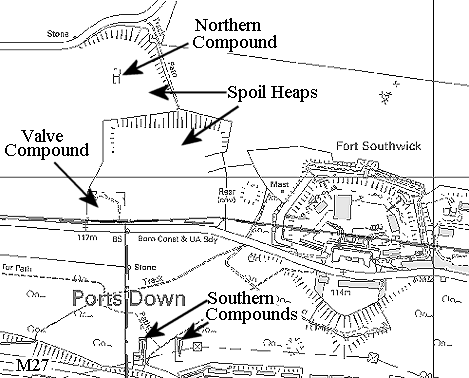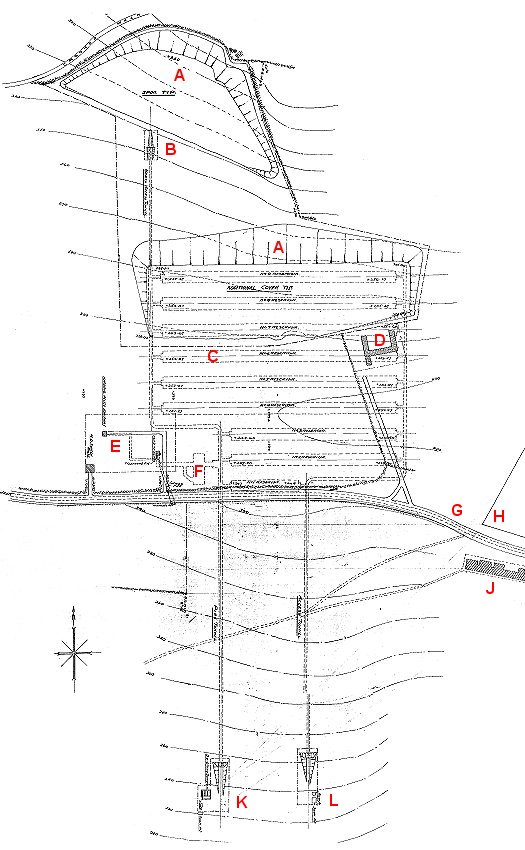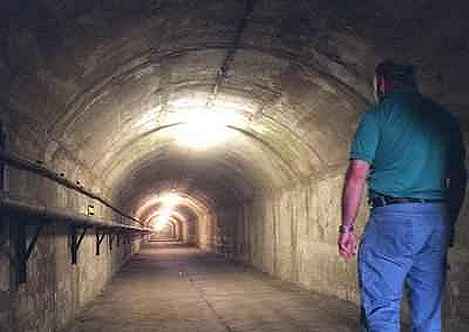|
|
On the Northern slope of
Portsdown the tunnel makes its final exit into open countryside. The distance between the
Southern portal
and this Northern portal is 500 yards. This site and the Valve compound
mentioned above are built on two massive spoil heap plateaus which were camouflaged
with grass and scrub.
|
|
|
|
With thanks to
Jeff,
Ian Dunkley, Bazzer, Peter Crowson and Peter Cobb for
their contributions.
|
|
|
|
|
|
| The
following are extracts from e-mails received:
|
|
|
|
|
|
NEW - 21-08-2021 |
|
|
Very unfortunate about the book, I would much rather read that than
the drivel autobiographies that are endlessly being released. Could
you not retry or try the PDF route again? That is assuming methods
may have become easier for editing [They haven't]. I was
looking forward to a different insight other than reading your
website. In 2007 it's quite possible that Ged [Hallam]
would have still been part of the secrets act, it was 2007 I first
went up there after finishing a late shift, I could see the tunnel
all lit up inside seeping from the mesh around the edge, which at
the time was a black door. I guess I took a step too close because I
set off an intruder alarm with a red flashing light and what can
only be described as a weird nuclear alarm echoing down the tunnel,
turned, ran and forgot about the steps I had just walked up. Ouch.
It's a very confusing situation regarding the tunnels.
My parents have filled me with various stories of their escapades
with the workers and site security for ASWE. Riding a moped that had
been dumped outside the west compound up tunnel to reach the pump
room ladder faster, Eric driving his car up the main tunnel and
having to reverse it out to the 400 yards or so of aerial cable ran
down into the complex so they could watch TV! They tell me of steps
under the hill that literally opened up as a hatch on the hill, they
are adamant it is not what they termed as angel steps inside the
fuel bunker. Trying to get a clearer picture so I could locate such
a thing is proving to be a slight pain because everything is so
overgrown.
My mother did ask him about any potential documents, all logs etc
had to be handed back in to the Navy and the Official Secrets Act
signed. He mentioned the inspection points dotted along the pipeline
so that you could go under them along with other tunnels that he
said are now collapsed in. If I can retrieve some solid information
on their whereabouts etc then I'll be sure to come straight back to
you.
Paul - August 2021 |
|
|
|
|
|
|
|
NEW - 29-04-2012 |
|
|
I've just seen your website and your
photos bring back many memories for me. I worked for Pritchard
Security in the 1980s and had to look after them. It was awful cold
damp and bloody eerie to say the least; walking round there turning
time clocks etc for £2 an hour. Have you ever tried to walk the ramp
there [the machinery ramp] that was a feat in itself, and Ged
the stoker ....all coming back to me now, any way good site loads of
memories.
Richard - April 2012 |
|
|
|
|
|
|
|
NEW - 29-04-2012 |
|
|
I was very interested to read
your piece in the Portsmouth News last night regarding the
Portsdown tunnels. My father was an engineer during the war working
at the Gosport Fuel Depot responsible for maintaining the pumps that
pumped the oil off the tankers into the storage tanks in the depot
and from there to the reservoirs under Portsdown Hill. As a child of
9 or 10 years at that time I would on occasions, during the school
holidays, go to work with him at Gosport and I remember once or
twice he took me into the fuel tunnels under the hill and, on one
occasion, we exited via a vertical shaft which came out on the top
of the hill just east of the roundabout at the top of Portsdown Hill
Road [the valve compound]. He told me that the tunnels were
mined so that they could be destroyed if the Germans ever
invaded. [Yes they were: with two tons of explosives] My
fathers name was Leslie Moffatt.
John Moffatt - April 2012 |
|
|
|
|
|
|
|
NEW - 19-09-2010 |
|
|
Having lived in the Portsmouth area all
my life I was astounded to read your excellent web site. I knew
about the fuel bunkers From 1961 when I was in the Fire Service as
we carried out our BA training at this site. However our training
records only Stated Portsdown and not where we had actually trained.
We Were told not to speak about the site to anyone This is the first
time that I have said anything as I signed accordingly. [The
Official Secrets Act].
In my time in the Fire Service we were
employed by the local Authority as Portsmouth City Fire Brigade, and
not until the Reorganization of Local Authorities did Portsmouth
merge with Hampshire and it became Hampshire Fire and Rescue. The
headquarters and training centre based at Eastleigh. I would have
thought that Portsmouth Fire Brigade records would have passed to
the Portsmouth Records Office.
Anonymous by request - August 2010 |
|
|
|
|
|
|
|
NEW - 23-10-2009 |
|
|
My husband is very interested to read
your site because he was born in1943 and brought up in Carlton Road
and remembers all sorts of stories. His father told him that the men
building the bunker and pipelines had to go in a decompression
chamber when they came out because of problems with the Bends. Also
that there were cornfields where Browning Avenue now is and that
animals kept falling down what the local children called The Well.
He said he can remember the big blue RN
Fuel tankers coming half way up Anson Grove to where there were big
metal doors on the ground. They connected all their pipes etc and
did whatever they did!! All the children used to go and watch. My
husband assumed they were taking fuel but reading the information on
your site it seems more likely they were putting it into the tanks.
He said the men used to wipe the pipes with cotton cloths which the
children took home to use as fuel for the fires (probably more
likely took into the fields and made their own little fires)!. He
also remembers light bulbs being thrown out from the tunnels ~ they
had screw fittings which he said were very unusual then. He was
around 7 or 8 at the time so it would have been late 1940s.
Jennie & Derek Penfold - June 2009 |
|
|
|
|
|
|
|
NEW - 23-10-2009 |
|
|
First let me say how much I love the
site. You’ve done a tremendous job. I was born in December 1946 at
St Mary’s and we lived 7 Hill Road Portchester. My father was at
that time employed by the Southern Electricity Board and had been
all during the war years. I remember him telling me about the fuel
bunkers by Fort Southwick and he always told me that they used to go
in and out by what I see you call the Valve Compound. He always told
me that he was responsible for all the cabling and wiring in the
Bunkers when they were built.
When I was 6 or 7 our Sunday morning was a walk up over the hill to
Southwick to the Red Lion (?) I sat outside with a bottle of pop and
a packet of Smith’s finest while Dad had his pint and then we would
walk back in time for Sunday lunch. I remember him showing me a
smaller tunnel half way down the hill which he always said was built
as an escape route from the fort if it was ever needed. He said that
there were two of them. I imagine that the construction of the M27
saw the end of those. I would guess that Dad had very probably seen
most of the inside of the Fort at some time or other. Dad was also
in the Home Guard but I don’t know which unit. After the war he
became a Special Constable in Portchester. I clearly remember him
going out in the evenings in his uniform.
John Wade - August 2009 |
|
|
|
|
|
|
|
NEW - 07-09-2008 |
|
|
I used to live and my parents still do
in Harting Gardens. Their back garden backs onto the alley way
which is the old pipe line route just by location D in your photos
in the pipeline section. When I was young, me and my friends used
to play football on the field and used the trees right by where
you took the photo of location D as the goal posts. I remember the
inspection pit, it was just the other side of the bush with the
red dog poo bin in front, and it was a rectangular checker plate
piece of metal about 2 x 1 meters in size. At some point they
filled it in with concrete and I can't remember if it was at the
same time but the whole area just in front of the chain link fence
of the school was dug up and then filled back in. I remember this
well as it turned half of our football area to mud and rubble! We
weren't happy. My parents told me that at some point in the 1980s
all the houses that backed onto the alley way between location C
and D tried to buy the parts of the alley way behind their houses.
They were told they couldn't as it was now seen as a path and it
would cause an inconvenience to people that were accustomed to
using it. This annoyed them as the section between location C and
Dore Avenue was sold off.
Adam Shepherd - September 2008 |
|
|
|
|
|
|
|
|
I worked for some years at the R.N. Oil Fuel Depot at Forton Rd. Gosport. During that time I made many visits to the
Portsdown storage reservoirs.
The main tunnel (south west entrance) as the plan
shows [see below], runs past the front of the reservoirs, and has a very slight incline, the drainage from the front of the reservoirs followed this incline to a pit in the SW compound which was emptied by tanker when full and taken to Gosport depot. When the tunnel passed the last (northernmost) reservoir it changed to a much steeper incline which made me puff to walk it, there was a solid door at the top
[northern portal] but this was never closed, instead there was an iron barred gate this allowed the tunnel to act as a very efficient ventilation system. The prevailing wind blew in at the south entrance, past the pump room and reservoir entrances sucking fumes out of them and taking them out at the north. The pump room floor is about 6/8 foot lower than the main tunnel floor.
...the main pumps at the Gosport depot were capable of pumping to
Portsdown. The Bedenham pumps were installed as booster pumps and were not always used.
...there is a lift shaft and a stairway
which runs down from the top compound, [so called valve
compound] these both open on to a
platform which leads via a 90% turn to a ramp which runs down to
the pump room, on the platform a door similar to a ship
bulkhead door had been let into the concrete wall, behind the door
was a room shaped like a small Nissan hut 15/20 foot long cut into
the chalk and lined with some sort of hard board under a
metal framework [This room was added during WWII and appears to
be some kind of telephone exchange] The pipeline ran under Fareham creek from
Wicor playing fields area (Portchester) into Fleetlands Aircraft
Repair Yard, close to Fleetlands jetty. It then turned south to the
Bedenham booster pumps, from there it ran to the oil fuel depot
Forton rd. Gosport following the military railway line which ran through
Frater and Elson armament yards to Priddy's Hard. From there it ran under
Forton creek into the oil fuel depot, there were no tanks between portsdown and the oil fuel depot.
The main pumps, 2 for furnace fuel oil, 1 for diesel, were situated in the oil fuel depot,
incidentally the pumps ran on D.C. current which was the power system used in
Gosport when the depot was built. When the supply was changed to
A.C. in Gosport an A.C / D.C. converter was installed in Clarence yard to keep the pumps supplied with
D.C. power.
The oil was pumped from the oil depot, under
Weevil lane, under Royal Clarence Yard to the oil jetty, which is now twice as long as it was originally built, it was then nearly always loaded into lighters which then delivered to ships in the dockyard.
When the M27 was built the pipelines were re-routed under the motorway in a tunnel.
Norman Beckett - July 2003
|
|
|
|
|
|
|
|
|
I read your site with great interest and having grown up close to the Oil Fuel Depot in Gosport. I started work as a JSA (junior storehouse assistant) in the Yard when I was 15 years old and by the time I was 18 I was transferred to the Oil Fuel Depot at Gosport, 1963.
I can recall that at that time we were pumping FFO
[Furnace Fuel Oil] from Portsdown on a regular basis. At the end of one particular Friday I was told that I had to go and collect some oil samples that had been forgotten from the Pump Room on the Hill. I was given the keys to the depots new Vauxhall Victor F and I drove from Gosport to the top
gate [west gate]. I had to unlock and then lock up each of the metal gates on the way down and to be honest I was absolutely petrified having been told some of the alarming stories by Paul Ferrier (the Storehouseman), Ted Wilden and other staff in the Depot.
However I managed to curb my fears and carry on with the task in hand. This was to collect some oil samples and return with them to the testing laboratory in the Depot. I went right through the entire complex except for the access tunnel on the east side, exploring as you would!!!
I even went to the north side gate, for which I didn't have a key.
I think the most amazing thing about the Pump Room were the pumps, all gleaming Green, Red with highly polished brass and steel. A real credit to the engineers who maintained them. Then the long climb back to the top, all the time having to unlock and re-lock the gates.
I must say that day was definitely a day to remember. Although after the walk home to Albert Street Mum said "Did you do any thing interesting today"? Worn out all I could say was "Not much Mum".
John McLeod, Storehouse Assistant, Oil Fuel
Depot, Forton Road, Gosport 1963-65 - November 2003
|
|
|
|
|
|
|
|
|
It was about 20 years ago [1983] when I went down
into the Fuel Bunkers. I was in the Fire Service at the time in Fareham. We had to go down as part of a Fire Service drill.
It took a long time to get down to the bottom & even longer to get back up (we had on breathing apparatus for the purpose of the drill only).
When we arrived at the bottom there were three big sheds
- like in a garden but a lot bigger. We understood that there were three shifts looking after the site each shift living in their own shed while on duty.
Each shed was fully kitted out for living in although I only went in one.
The bottom was huge, as big as a cathedral, no supports just a great
big dome. Leading off from the centre were huge mouse holes (tunnels) they seemed to go on for miles!
I was told that the tankers berthed in Gosport on the oil fuel jetty
at Clarence Yard and the oil was pumped up to the top of the hill via
pipes that went under the harbour.
Alan Scutt - Ex Fire Service - November 2003
|
|
|
|
|
|
Aerial
photo site location Panoramic
photo site location
|
|
Google
Earth Aerial View
|
|
Visit
this site - Portsdown Walk No2
|
|
|
|
|
|
|

|
|
Map
showing the fuel bunker surface layout.
| Northern |
SU623072 |
| Valve |
SU622069 |
| Southern |
SU624066 |
|
|
|
|



